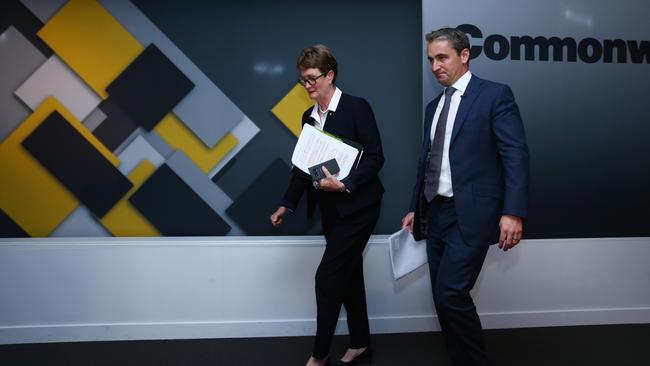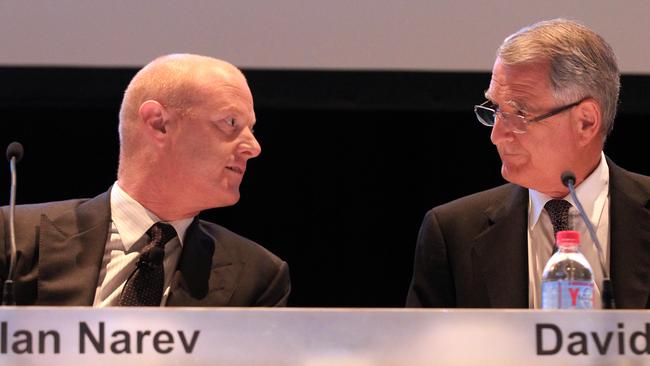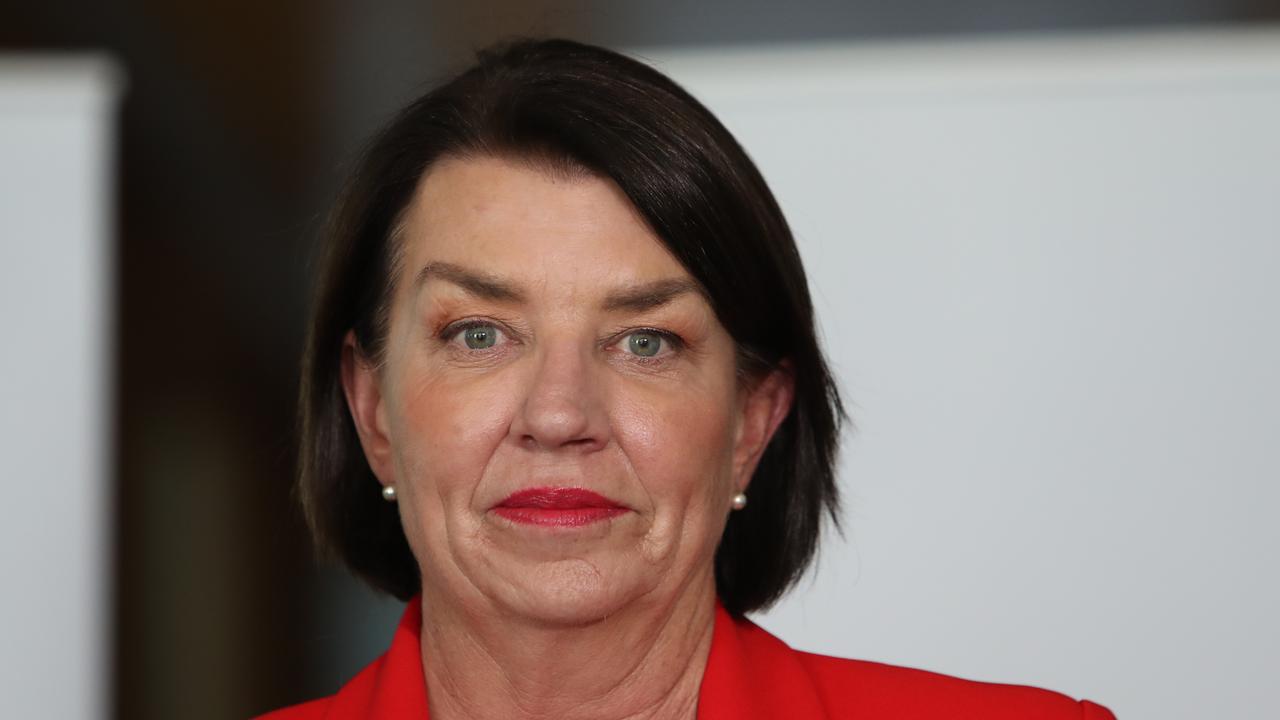CBA’s problems started at top
CBA has managed to avert any serious discussion of the key relationship in the bank during its long slide into disrepute.

In 2½ days of deep navel-gazing in the financial services royal commission this week, Commonwealth Bank managed to avert any serious discussion of the key relationship in the bank during its long slide into disrepute.
“Noses in, fingers out” is the agreed maxim for a cohesive board — directors should stick their noses into governance matters but keep their fingers out of management.
The question for CBA is whether its long-serving chairman David Turner, who stepped down in late 2016 after seven years in the plum role, stayed true to a different mantra: “Noses out, fingers out”.
“David had a lot of time for Ian (Narev, former CEO); he was very trusting of him and Ian was very trusting of his own team,” a source close to the board says.
“It was all about collaboration and empowerment.”
The relationship between Turner and Narev served as a model for the rest of the bank.
As Narev’s successor Matt Comyn said on Monday, only minutes into his marathon appearance, there was a huge focus on collaboration in CBA from about 2006.
The objective was to improve staff engagement and lead to better problem solving.
“But actually, what happened over a period of time is it led to more consensus, compromise and an inability to resolve difficult issues,” Comyn said.
Already, this was difficult territory to traverse, and the CBA chief would have been well aware it would only get worse.
Senior counsel assisting Rowena Orr QC knew it, too.
When Comyn referred to an unnamed case study as a useful example, Orr inquired: “Which one, Mr Comyn?”
“Consumer credit insurance,” he deadpanned.
It would take Orr a full day to return to the gory detail of CBA’s consumer credit insurance debacle, for which she came armed with damning exhibits that were ready to project to the world on a large screen.
On Tuesday, Orr took Comyn to a meeting he had with Narev on May 28, 2015, when the then-head of the retail bank unsuccessfully pitched his boss to cease selling junk insurance policies to unsuspecting customers.
When the exhibit flashed up, it showed Comyn’s contemporaneous note of the meeting, including a now-notorious instruction from Narev to “temper your sense of justice”.
Comyn said he took it to mean: “Calm down”.
Orr persisted, asking him why he had not approached the chairman or the board after several failed attempts to convince the bank to exit from an annual profit stream of $150 million.
“I think the chairman at that point of time would have relied solely on Mr Narev’s recommendation,” Comyn said.
Turner was not mentioned by name.

However, it was the only specific reference in 2½ days to one of the real-life consequences of the overly tight relationship between the chairman and CEO.
Last May, the prudential regulator handed down its searing review of CBA’s culture and governance, which was commissioned after Austrac sensationally tapped the bank for multiple anti-money-laundering transgressions in August 2017.
It is now the blueprint for new chair Catherine Livingstone’s comprehensive reform agenda.
The review smashed CBA for its sense of complacency, lack of appreciation for financial risks, being reactive and insular, and its emphasis on a collaborative working environment that impeded accountability.
It was a savage, 109-page indictment of the bank, which Comyn managed to distil to 2½ pages in his witness statement for the royal commission.
In short, CBA’s disease was failing to consistently prioritise customer interests, with the manifestation “an escalating cycle of funding remediation/resolution/rectification, rather than simplification of systems and processes”.
“We have focused on aggregate customer outcomes and satisfaction, and paid insufficient attention to individual outcomes for some customers,” Comyn said.
“Our approach to remediation was inconsistent, and was often incremental and too slow.”
CBA’s sense of complacency has taken a savage hit, with Comyn this week delivering many of the blows himself.
Outsiders have seen this as a classic case of a new CEO throwing his predecessor under the bus.
Insiders, including some of Narev’s supporters, believe Comyn had little choice.
It was inevitable that the dragnet used by the royal commission would capture Comyn’s note about his 2015 meeting with Narev over consumer credit insurance, and it was an impossible task to defend management in the face of the APRA review.
Still, one former a CBA executive said Comyn’s attempts to shift blame to Narev, and the way in which it happened, did not bode well for the bank’s future culture.
“This path of really throwing people under a bus publicly will have meaning for the organisation operationally,” the former CBA executive said.
“Employees will feel unnerved and that everyone is on their own. Narev’s motivations were good, but if he had a weakness it was that he didn’t fire executives for their failings.
“There has been legitimate debate about Matt’s moral authority to lead the bank, given he had been in charge of the retail bank, which was responsible for the anti-money-laundering failings.”
At the same time Livingstone, who joined the board in March 2016 and became chair in January last year, will have a tough time re-asserting her authority.
The only other candidate for chair, former Lendlease boss David Higgins, pulled out of the race before the board resolved by circular resolution to elect Livingstone after its October 2016 meeting.
The criticism by CBA insiders of Livingstone’s evidence this week is that she presented herself as the bank’s saviour — “putting my reputation on the line”, as she said on Wednesday morning — without taking any of the heat from her nine-month period on the board before becoming chairman. Part of this effort, they say, resulted in a misstep with her claim to have challenged management at the October 2016 board meeting over its inadequate response to the ongoing Austrac investigation.
Orr took Livingstone to minutes of the meeting, which had no record of Livingstone’s challenge.
Under the heading of regulatory report, the minutes merely noted that CBA had responded to the statutory notices from Austrac, the fact that “there had been no further correspondence to date” and that the board had discussed and noted the report.
Livingstone responded that the minutes didn’t record every single conversation, but the exchange did occur.
This opened CBA up to the serious allegation of failing to keep adequate board minutes.
While sources close to the board say it’s quite possible that Livingstone raised a question about Austrac, it wasn’t a big challenge worthy of inclusion in the minutes.
The whole episode plays squarely into the APRA report and Comyn’s personal assessment that CBA did not appreciate the “gravity” of the failures to comply with its obligations.
Insiders say everyone on the board was well aware of the seriousness of the Austrac investigation, but it didn’t anticipate that Austrac would barely give any notice of its intention to launch proceedings.
“If anything, it’s Catherine who’s thrown everyone under the bus, presenting them as hopeless and incompetent,” a source says.
“It’s like she alone made the decision to cut management bonuses, appoint Matt as CEO and everything else that’s been done.”
No one, however, doubts Livingstone’s work ethic, commitment or diligence.
Turner’s style was less intrusive, often with a contrarian point of view.
In the last year or so of his term as CBA chairman, Turner’s family returned to the UK, to which he would frequently commute to see them.
Comyn believes he would have got a very different reaction from Livingstone if she’d been chairman in 2015 and he’d brought the bank’s sale of junk consumer credit insurance to her attention.
For the moment, CBA has probably enough crises to bother with road-testing the Comyn way of doing things.
Additional reporting: Joyce Moullakis



To join the conversation, please log in. Don't have an account? Register
Join the conversation, you are commenting as Logout